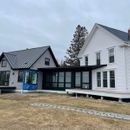Antique Rubble Wall Basement Treatment
Hi, We are just finishing renovating and adding onto a 1880 vintage house on the coast of Maine.
We have a new 6’ basement and a new 4’ crawlspace. Both of those fully insulated with ICF foundation and are both warm and dry. We did however preserve the original 7’ high x 1000sf basement that we think dates back to 1780. It now has a sump pump and a dehumidifier but it is a bit cold and damp (the boiler was moved and replaced in the newer adjacent basement). So no source of heat in there anymore. There is a 3’ passage way between the new and old basements
You can see right through the cracks of the 140 hr old pine floors to the basement. Worried about the transfer of damp air, bugs, rodents, heat loss from the 1st floor.
– Thinking of adding Rockwool insulation under the floor from the basement side.
Question- should I first put in a vapor barrier or some breathable fabric to reduce air exchange (and rockwool fibers) from the basement to the rest of the house ?
the builder just tried some 3” weatherproofing tape on the floor gaps. To see it that will remain stuck ?
2nd question – I was wondering if spraying insulation from the rim joists down about 3’ (the the elevation of the outside grade) would be beneficial ? For cold, bugs, rodents. However, worried about trapping moisture in the rubble wall and having it freeze and crumble the stone and mortar ?
Do you think that would help or hurt?
We also reserved a HW baseboard pump/zone to add a baseboard in the portion of basement if if needs heat. But, it has been hovering around 55 degrees (I think, as I have not measured).
The new parts of the house are well insulated with 6” of Rockwool, 1 1/2” of blue polystyrene, and Blue Skin WRB the old part of the house gained 1” of polystyrene and Blue Skin over the old sheeting before we resided it.
Any advice would be super helpful
Thank You!
New Retiree on the coast of Maine
Don
GBA Detail Library
A collection of one thousand construction details organized by climate and house part











Replies
Have you read this article:
https://buildingscience.com/documents/insights/bsi-041-rubble-foundations#P08
?
I'm slowly working on a similar project at my house, an 1830 Cape on the border of midcoast and central Maine. I'm more or less following the approach that DC linked to. If you're interested, you can follow along: https://www.instagram.com/reel/C27xp9srK6O/.
I have learned to avoid creating interstitial spaces, those that are neither fully interior or exterior, as it's hard to predict what will happen in them and they are at high risk of mold/microbial action. Insulating the floor instead of the foundation walls would create such a space.